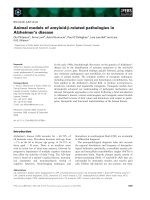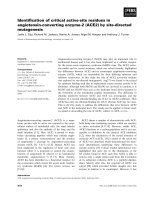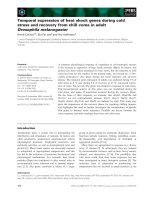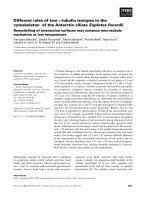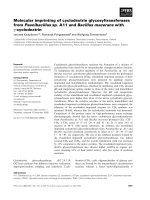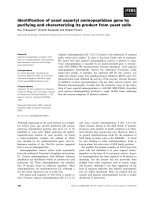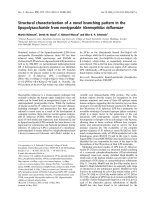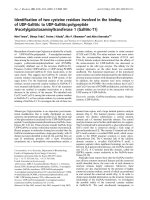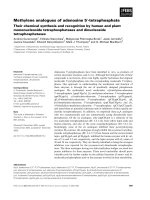Báo cáo khoa học: "Study protocol of the German "Registry for the Detection of Late Sequelae after Radiotherapy in Childhood and " ppsx
Bạn đang xem bản rút gọn của tài liệu. Xem và tải ngay bản đầy đủ của tài liệu tại đây (218.19 KB, 4 trang )
BioMed Central
Page 1 of 4
(page number not for citation purposes)
Radiation Oncology
Open Access
Study protocol
Study protocol of the German "Registry for the Detection of Late
Sequelae after Radiotherapy in Childhood and Adolescence" (RiSK)
Tobias Bolling
1
, Andreas Schuck
2
, Hildegard Pape
3
, Christian Rube
4
,
Barbara Pollinger
5
, Beate Timmermann
6
, Rolf D Kortmann
7
,
Karin Dieckmann
8
and Normann Willich*
1
Address:
1
Department of Radiotherapy, University Hospital of Münster, Germany,
2
Radiotherapy Facility, Memmingen, Germany,
3
Department
of Radiotherapy, University Hospital of Düsseldorf, Germany,
4
Department of Radiotherapy, University Hospital of Homburg/Saar, Germany,
5
Department of Radiotherapy, University Hospital of Munich, Germany,
6
Department of Radiotherapy of the Paul-Scherrer-Institute, Villigen,
Switzerland,
7
Department of Radiotherapy, University Hospital of Leipzig, Germany and
8
Department of Radiotherapy, University Hospital of
Vienna, Austria
Email: Tobias Bolling - ; Andreas Schuck - ; Hildegard Pape - papeh@uni-
duesseldorf.de; Christian Rube - ; Barbara Pollinger - ;
Beate Timmermann - ; Rolf D Kortmann - ;
Karin Dieckmann - ; Normann Willich* -
* Corresponding author
Abstract
Background: Late effects after radiotherapy in childhood and adolescence have mainly been
characterized retrospectively with small patient numbers. However, these analyses are limited due
to little information regarding organ dose levels in many cases. To overcome this limitation, the
German Group of Paediatric Radiation Oncology (APRO) established the „Registry for the
evaluation of late side effects after radiation in childhood and adolescence” (RiSK). The study
protocol and the documentation forms are given in this publication.
Methods/Design: Radiation parameters including detailed organ doses as well as toxicity
evaluations are collected prospectively from centres all over Germany. Standardized
documentation forms are used. These forms are given in an English and German version as
additional files to this publication. Documentation is planned for all children who receive
radiotherapy in one of the therapy trials of the "German Society of Paediatric Oncology and
Haematology (GPOH)". The study started in a pilot phase in June 2001 in few centres. Since 2004
documentation has been performed all over Germany and is still on-going.
Discussion: To our knowledge, "RiSK" is the only multi-centre study that evaluates radiation
associated side effects prospectively with detailed information about organ dose levels. With
ongoing recruitment and prolongation of follow-up powerful data will be obtained in a few years.
A broad use and international cooperation are welcome.
Published: 21 April 2008
Radiation Oncology 2008, 3:10 doi:10.1186/1748-717X-3-10
Received: 28 January 2008
Accepted: 21 April 2008
This article is available from: />© 2008 Bolling et al; licensee BioMed Central Ltd.
This is an Open Access article distributed under the terms of the Creative Commons Attribution License ( />),
which permits unrestricted use, distribution, and reproduction in any medium, provided the original work is properly cited.
Radiation Oncology 2008, 3:10 />Page 2 of 4
(page number not for citation purposes)
Background
Radiotherapy is of fundamental importance in paediatric
oncology. Individual decisions for the use of ionizing
radiation always have to consider the potential benefit
and possible side effects. Whereas the benefit is no matter
of major discussions, the risk for potential side effects like
secondary malignancies and non-cancer health effects
cannot be quantified based on sufficient data. Especially,
there is a lack of information regarding dose-effect rela-
tionships of ionizing radiation. This is of special impor-
tance when ionizing radiation is used in childhood and
adolescence due to potential higher vulnerability of grow-
ing tissue and longer expected life span [1-3]. For radio-
therapy, late effects after treatment in childhood and
adolescence have mainly been characterized retrospec-
tively with small patient numbers [4-7]. Many of these
analyses are limited due to little information about organ
dose levels and older radiation techniques in some cases.
Recently, the characterization of late effects after cancer
therapy in childhood including chemotherapy, surgery
and radiation has been of rising interest [8,9]. Several
study groups in a variety of countries have developed
strategies to characterize different aspects of late effects. In
Germany, several study groups like the "Late Effects Sur-
veillance System" (LESS) [10,11] or the working group
"Quality of life" [12] have been established. The largest
examination has been performed in the United States of
America: The "Childhood Cancer Survivor Study" has
been established to characterize retrospectively the health
status of 5-year-survivors of childhood cancer. In these
studies, more than 12,000 patients were evaluated by
questionnaires regarding their health status [8]. For radia-
tion exposure, this study cannot give very detailed infor-
mation about organ-dose level associated late side effects
due to quite insufficient data regarding radiation organ
dose levels. So this approach turned out to be not suffi-
cient in view of answering open questions regarding the
risks of radiotherapy in childhood and adolescence.
Methods/Design
To overcome the described lack of information and to
receive detailed data regarding the risk of radiotherapy in
childhood and adolescence, the German Group of Paedi-
atric Radiation Oncology (APRO), a working group of the
"German Society of Radiation Oncology" (DEGRO) and
the "German Society of Paediatric Oncology and Haema-
tology" (GPOH) established the „Registry for the evalua-
tion of late side effects after radiation in childhood and
adolescence” (RiSK) [1-3]. The aim of this prospective
multi-centre registry study is to evaluate radiation dose-
effect relationships in organs and part of organs with spe-
cial regard to late side effects. Documentation is planned
for all children who receive radiotherapy in one of the
therapy optimizing study trials of the GPOH. The docu-
mentation of radiotherapy is performed through local
radiotherapists; the documentation forms are reviewed
and collected in the study centre in Münster. In addition,
the names of children who receive radiotherapy are col-
lected from the therapy study centres of the GPOH study
trials. The documentation forms of these patients are
asked for in the departments of radiotherapy if no docu-
mentation has been performed. Parents' declarations of
consent for data transfer have been integrated into most of
the study protocols of the GPOH that are relevant in view
of radiotherapy. Therefore additional declarations of con-
sent are not necessary in Germany. The first toxicity eval-
uation, i.e. the documentation of acute toxicities, is
scheduled at 6–8 weeks after the end of radiotherapy.
Later on, toxicity evaluations have to be performed once a
year. The evaluation of toxicities is performed either by
the radiation oncologists or, due to problems in some
departments, by the treating paediatric oncologists.
In a first step of RiSK, its structure was established and the
documentation forms were developed. They include the
evaluation of the treatment period, the fractionation
schedule, the target volume(s) as well as the radiation
techniques and doses including detailed information
about organ dose levels. A study group (see Acknowledge-
ments) of the APRO defined doses for each organ that
should lead to documentation if these doses are reached.
Beside the documentation of the maximum doses for
some organs, the dose-volume histograms have to be
characterized for the lungs, the heart, the liver and the kid-
neys. In case of the thyroid gland and the testes, dose
measurements have to be performed. Surgery and chemo-
therapy are evaluated as well. Toxicity documentation is
performed according to EORTC/RTOG criteria [13],
adapted to paediatric values. The toxicity is characterized
in 5 degrees (0 = no side effect, 4 = severe side effect) for
each organ. There is no need for additional examinations
in follow-up because the toxicity evaluations refer to the
standard follow-up examinations. The study flow chart is
given in Table 1. The documentation forms are available
in the internet [14] and given as additional files to this
publication in an English (see additional file 1) and a Ger-
man (see additional file 2) version. The documentation
for RiSK started in July 2001 with a pilot phase in few
study centres. During this period, the documentation
forms have been re-evaluated and adapted to the practical
need. Since February 2004, the documentation has been
performed all over Germany in a multi-centre way. The
feasibility of "RiSK" has already been shown [1] and first
results have recently been published [2,3].
Discussion
Sufficient data regarding radiation associated late seque-
lae after radiotherapy in childhood and adolescence with
special emphasis on organ dose-volume effects do not
exist. Due to the lack of detailed organ dose evaluation in
Radiation Oncology 2008, 3:10 />Page 3 of 4
(page number not for citation purposes)
the pre-3-D-treatment planning era, retrospective analyses
can only be performed with very uncertain estimations of
the radiation doses at special organs. To our knowledge,
"RiSK" is the only multi-centre study that evaluates radia-
tion associated side effects prospectively with detailed
information about organ dose levels. With ongoing
recruitment and prolongation of follow-up powerful data
will be obtained in a few years. The described study proto-
col and the documentation forms are open for the use by
other study groups. To further increase the number of
patients in order to obtain faster results, an international
cooperation with other study groups evaluating radiation
associated side effects after radiotherapy in childhood and
adolescence is welcome.
Abbreviations
APRO: Working Group Paediatric Oncology ("Arbeits-
gruppe Pädiatrische Radioonkologie"); DEGRO: German
Society of Radiation Oncology ("Deutsche Gesellschaft für
Radioonkologie"); EORTC: European Organisation for
Research and Treatment of Cancer; GPOH: Germany Soci-
ety of Paediatric Oncology and Hematology ("Gesellschaft
für pädiatrische Onkologie und Hämatologie"); RiSK: Registry
for the evaluation of late sequelae after radiotherapy in
childhood and adolescence ("Register zur Erfassung von
Spätfolgen nach Strahlentherapie im Kindes- und Jugendal-
ter"); RTOG: Radiation Therapy Oncology Group.
Competing interests
The authors declare that they have no competing interests.
Authors' contributions
TB is the study coordinator of RiSK, participated in the
development of the study trial and drafted the manu-
script. AS, HP, CR, BP, BT, RDK and KD participated in the
design of the registry study and are involved in continuing
optimization. NW is the study chairman of RiSK, devel-
oped the design of the registry study, is involved in con-
tinuing optimization and helped to draft the manuscript.
All authors read and approved the final manuscript.
Additional material
Acknowledgements
RiSK is supported by the German Children's Cancer Foundation („Deut-
sche Kinderkrebsstiftung”), Bonn, Germany.
We thank all persons performing documentations in departments of radio-
therapy and paediatric oncology.
Additional file 1
RiSK-documentation form English. This file is the English version of the
original German RiSK documentation form.
Click here for file
[ />717X-3-10-S1.pdf]
Additional file 2
RiSK-Dokumentationsbogen Deutsch. This file is the original German
version of the RiSK documentation form.
Click here for file
[ />717X-3-10-S2.pdf]
Table 1: Study flow chart.
Timepoint Documentation Special needs
Treatment planning and radiotherapy Basic data (see documentation form part 1)
Organ doses (see documentation form part 2) 1. Dose-volume-histogram for lungs, heard,
liver and kidneys, if in radiation field. Therefore
CT-based treatment planning is mandatory if
irradiation is performed to the thorax or
abdomen.
2. Dosimetry of the thyroid gland
if irradiation
in head/neck area or mediastinum
3. Dosimetry of the testes
if irradiation is
performed to the abdomen or to the upper
part of the lower extremity
6–8 weeks after end of radiotherapy
Follow-up examination
Documentation of maximal side effects that
occured during or few weeks after
radiotherapy according RTOG/EORTC criteria
(see documentation form)
Only clinical examination
1 year after end of radiotherapy: follow-up
examination
Evaluation of late sequelae according to RTOG/
EORTC criteria (see documentation form)
Only clinical examination, blood values to be
asked from paediatricians
2nd-10
th
(if feasible) year after radiotherapy
follow-up examination 1×/year
Evaluation of late sequelae according to RTOG/
EORTC criteria (see documentation form)
Only clinical examination, blood values to be
asked from paediatricians
The documentation forms have to be sent to the RiSK study trial center in Münster: RiSK-Study trial centre, Department of Radiotherapy,
University Hospital of Münster, Albert-Schweitzer-Str. 33, D-48129 Münster, Germany, Phone: +49-251-83-47384, Fax: +49-251-83-47355, E-Mail:
Publish with BioMed Central and every
scientist can read your work free of charge
"BioMed Central will be the most significant development for
disseminating the results of biomedical research in our lifetime."
Sir Paul Nurse, Cancer Research UK
Your research papers will be:
available free of charge to the entire biomedical community
peer reviewed and published immediately upon acceptance
cited in PubMed and archived on PubMed Central
yours — you keep the copyright
Submit your manuscript here:
/>BioMedcentral
Radiation Oncology 2008, 3:10 />Page 4 of 4
(page number not for citation purposes)
We thank the members of the initial study group of the APRO who defined
the organ doses for documentation: M. Albrecht (Berlin, Germany), K.
Dieckmann (Vienna, Austria), M. Herbst (Regensburg, Germany), R D.
Kortmann (Tübingen, now: Leipzig, Germany), H. Pape (Düsseldorf, Ger-
many), B. Pöllinger (Munich, Germany), R. Pötter (Vienna, Austria), C. Rübe
(Münster, now: Homburg, Germany), N. Willich (Münster, Germany) and
R. Wurm (Berlin, Germany).
References
1. Bölling T, Schuck A, Rübe C, Hesselmann S, Pape H, Dieckmann K,
Pöllinger B, Kortmann RD, Speiser-Held I, Meyer FM, Martini C,
Asadpour B, Timmermann B, Beck JD, Langer T, Paulides M, Schmidt
B, Willich N: Therapy associated late effects after irradiation
of malignant diseases in childhood and adolescence. Strahlen-
ther Onkol 2006, 182:443-449.
2. Bölling T, Schuck A, Pape H, Rübe C, Meyer FM, Martini C, Timmer-
mann B, Asadpour B, Kortmann RD, Beck JD, Langer T, Paulides M,
Könemann S, Willich N: Register for the evaluation of side
effects after radiation in childhood and adolescence – first
results. Klin Päd 2007, 219:139-145.
3. Bölling T, Schuck A, Pape H, Rübe C, Meyer FM, Martini C, Timmer-
mann B, Asadpour B, Kortmann R-D, Beck JD, Langer T, Paulides M,
Willich N: German register for detection of late sequelae
after radiotherapy for children and adolescents (RiSK):
Present status and first results. Strahlenther Onkol 2007,
183(Suppl 2):7-8.
4. Flentje M, Weirich A, Pötter R, Ludwig R: Hepatotoxicity in irra-
diated nephroblastoma patients during postoperative treat-
ment according to SIOP9/GPOH. Radiother Oncol 1994,
31:222-228.
5. Fuss M, Pojanc K, Hug EB: Full scale IQ (FSIQ) changes in chil-
dren treated with whole brain and partial brain irradiation.
Strahlenther Onkol 2000, 176:573-581.
6. Schuck A, Hamelmann V, Brämswig J, Könemann S, Rübe C, Hessel-
mann S, Riesenbeck D, Horst E, Bölling T, Paulussen M, Jürgens H,
Willich N: Ovarian function following pelvic irradiation in pre-
pubertal, pubertal and young adult women. Strahlenther Onkol
2005, 181:534-539.
7. Tarbell N, Guinan E, Chin L, Mauch P, Weinstein H: Renal insuffi-
ciency after total body irradiation for pediatric bone marrow
transplantation. Radiother Oncol 1990, 18(Suppl 1):139-142.
8. Oeffinger KC, Mertens AC, Sklar CA, Kawashima T, Hudson MM,
Meadows AT, Friedman DL, Marina N, Hobbie W, Kadan-Lottick NS,
Schwartz CL, Leisenring W, Robison LL: Chronic Health Condi-
tions in Adult Survivors of Childhood Cancer. N Engl J Med
2006, 355:1572-1582.
9. Calaminus G, Kaatsch P: Positionpaper of the Society of Pediat-
ric Oncology and Hematology (GPOH) on (long-term) sur-
veillance, (long-term) follow-up and late effect evaluation in
pediatric oncology patients. Klin Pädiatr 2007, 219:173-178.
10. Beck JD, Winkler K, Niethammer D, Brandis M, Hertzberg H, Hardt
K von der, Greil J, Überall MA, Rossi R, Lamprecht-Dinnesen A,
Brämswig J, Kaatsch P, Michaelis J, Meier W, Hausdorf M, Bielack S,
Dörr HG: After care of children and young adults surviving
cancer. Initial recommendations by the late sequelae study
group. Klin Pädiatr 1995, 207:186-192.
11. Langer T, Stöhr W, Bielack S, Paulussen M, Treuner J, Beck JD: Late
effects surveillance system for sarcoma patients. Pediatr Blood
Cancer 2004, 42:373-379.
12. Calaminus G, Kiebert G: Studies on health-related quality of life
in childhood cancer in the European setting: an overview. Int
J Cancer Suppl 1999, 12:83-86.
13. Cox JD, Stetz J, Pajak TF: Toxicity criteria of the Radiation
Therapy Oncology Group (RTOG) and the European Organ-
ization for Research and Treatment of Cancer (EORTC). Int
J Radiat Oncol Biol Phys 1995, 31:1341-1346.
14. RISK documentation forms [ />institute/radonk/radtox.htm]
